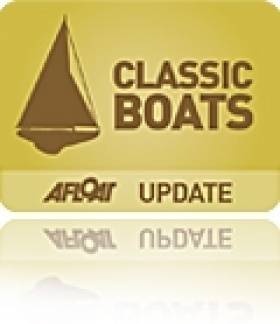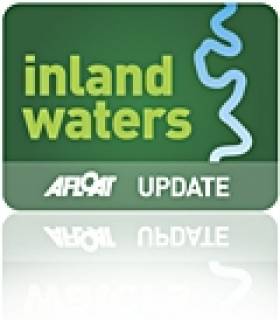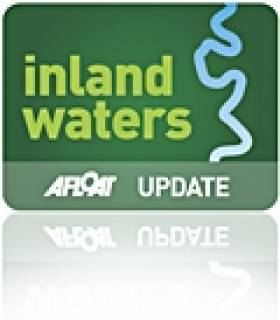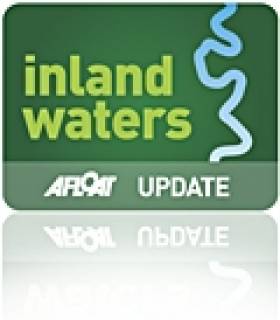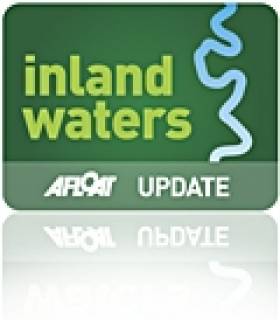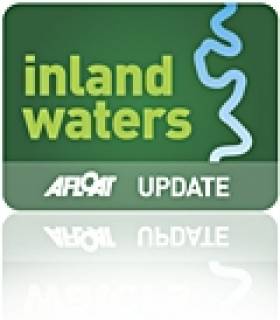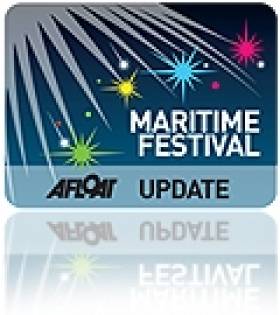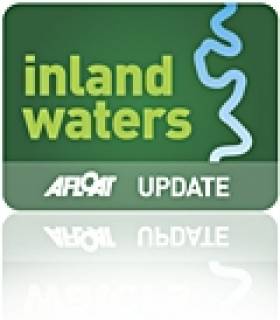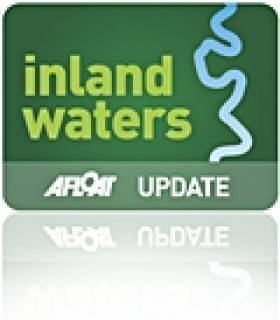Displaying items by tag: Grand Canal Dock
#NaomhÉanna - Afloat.ie previously reported that restoration of the former Aran Islands ferry Naomh Éanna required solid financial backing before a number of ambitious future plans for the boat could proceed.
Now campaigners for the historic vessel have turned to the internet to seek funding for the first step of their rejigged refurbishment plan – now starting with the proposed micro brewery.
Organisers believe that setting up the brewery first – with a funding target of €3,000 for the necessary equipment and licences – will provide the revenue stream needed to get further restoration works in motion, as well as "show investors and banks that we are actually doing something", as the project's IndieGoGo page explains.
It's hoped that the micro brewery will operate from the Naomh Éanna at its Grand Canal Dock berth – and tours of the ship and the proposed brewing facilities are among the perks available for contributors to the crowdfunding campaign, which has 55 days left to go as of Wednesday 20 May.
#workspace – As Afloat.ie reported last week, "DoSpace.ie" Ireland's newest and most unique CoWorking space launched today in Grand Canal Dock, part of Dublin's Silicon Docks area on Ireland's Inland Waterways.
Occupying an 800 square foot, state of the art barge, DoSpace provides CoWorkers with short or long term desk space in Dublin 2.
It was founded by Graham Barker following his own fruitless search for reasonably priced and fun Silicon Docks office space. Graham, with support from Waterways Ireland, sourced and refitted The Grey Owl, one of Ireland's premier barges. The result, according to Barker, is both an affordable solution and a quirky work environment.
Speaking about the project, Graham said, "This is the kind of place that people want to work in – it's centrally located, next to the Dart, a Dublin Bikes stand across the road, beside all the big tech companies, and we are on the water! Everyone I've met has been very supportive – from Waterways Ireland to the CoWorking space community. I think most people can see the benefit that we bring to the area, and the sheer value that we offer to startups".
Commenting on the new start-up, Dawn Livingstone - Waterways Ireland Chief Executive said "We are really happy to have been able to work with DoSpace to bring this CoWorking business to the Grand Canal Dock. The Dock offers unique opportunities for business with the focus of technology businesses here in the area. There is an excellent range of startup and high growth businesses ready to take advantage of DoSpace CoWorking"
Grand Canal Dock is referred to as Silicon Docks because of the large concentration of technology companies and is seen by many as a symbol of Ireland's economic recovery. Tech giants like Facebook and Google, together with a myriad of smaller technology companies, have their European headquarters located here alongside incubation centres, such as Trinity's Technology and Enterprise campus.
One early adopter of DoSpace is Security First, a London based start-up creating tech to help human rights defenders work safely. Co-founder, Holly Kilroy, said "I've been blown away by the location and how useful the DoSpace community has been to us already. Having such a well connected CoWorking space in Dublin has saved us time and money and made it easier to move the company home."
DoSpace Dublin will be managed by David Bragason, DoSpace's Dublin's Community Manager. Tours of the DoSpace barge can be booked via their website at http://www.dospace.ie or by contacting David at 01 539 7935. Membership plans start from €50 a month. DoSpace is giving 10% of their desk space free of charge to nonprofit technology based startups.
#Docklands - World-class wakeboarding comes to Dublin's Grand Canal Dock this weekend (16-17 May) at the Waterways Ireland Docklands Summer Festival 2015.
Prepare to be wowed as the world's best wakeboarders showcase an array of grabs, spins and tricks, including European champion Carro Djupsjo from Sweden, British champion Meg Barker and Irish champion David O'Caoimh.
Organised by the Docklands Business Forum, the festival attracted over 60,000 visitors across the two days in 2014, with an even greater attendance expected this year.
The weekend will see an abundance of entertainment and competitions on both the water and the land. With everything from open air DJs, water sport come-try-it-sessions, a water golf challenge (with floating golfing green) to the tricky FM104 Corporate Raft Challenge, there will be plenty in store for a fantastic day.
The world-class wakeboarding demonstrations will feature a first ever for Ireland, with the public voting for the best performer through the unique DockFest15 voting app and big screen.
And there's lots on offer for the kids too including a 'rubber ducky' race, a children's arts centre at the Waterways Ireland Visitor Centre, a family funfair, champion street performers and international food markets.
For more visit www.docklandssummerfestival.com.
Co-Working Space Takes To The Water At 'Silicon Docks'
#SiliconDocks - Office space is at a premium for the Dublin tech business community located around the so-called 'Silicon Docks', with many start-ups hampered by high commercial rents and landlords' unrealistic expectations.
But as RTÉ News reports, one enterprising business thinks it's found a solution for the newest additions to the booming tech scene - with a floating office right in the heart of Grand Canal Dock.
DoSpace offers flexible co-working space to up-and-coming companies, entrepreneurs and freelancers on board its converted canal barge, the Grey Owl, at berth number 7 in Grand Canal Dock Marina.
With no advertising, word of mouth has seen the space attract a variety of internet and creative start-ups with differing needs, from those that require a dedicated office to freelancers who only need a desk or a meeting room on occasion.
And demand is such that DoSpace has already ordered a second barge to expand its services and provide affordable workspace to today's more flexible knowledge workers.
RTÉ News has more on the story HERE.
Learn About Ireland's Canals Sugar Heritage On Culture Night
#InlandWaters - Waterways Ireland joins in the Culture Night festivities on Friday 19 September with a special event tracing the history and heritage of the sweet foodstuff on Ireland's canals and inland waterways.
Live demonstrations of sugar work and delicious deserts from home and abroad will be available to tickle your tastebuds at the Waterways Ireland Visitor Centre on Grand Canal Dock from 6.30pm till 9pm on the night.
Admission is free but booking ahead is advised – call 01 677 7510 for details.
Future of Graving Docks in Limbo as Plot 8 is Transferred to NAMA
#INLAND WATERWAYS - The site of the former graving docks at Grand Canal Dock has been transferred to NAMA in a deal which frees the Dublin Docklands Development Authority (DDDA) from a €29 million plus bank guarantee.
Plot 8 at Sir John Rogerson's Quay is one of a suite of nine sites that have been transferred to the Government's 'bad bank' in a negotiated loan settlement that extricates the Docklands body from loan guarantees given by banks that financed the "disastrous" Dublin Glass Bottle site deal in 2006.
Sites handed over in the deal include the former 'U2 Tower' and the historic BJ Marine premises on the banks of the Liffey, as well as the aforementioned Dublin Glass Bottle site.
The Dublin branch of the Inland Waterways Association of Ireland (IWAI) had been hoping to embark on a restoration of the graving docks at Plot 8 to their former working order (a detailed history of the docks and restoration plans is available HERE).
This project had been given the blessing of the DDDA and Waterways Ireland, which owns the freehold lease on the site, with a view to its restoration helping to fund the Ulster Canal scheme.
However with the transfer of the DDDA's interest in the site to NAMA, the authority has now withdrawn permission for the IWAI to do any restoration work, leaving the future of the graving docks in limbo.
Largest Vessel Transits Samuel Beckett Swing-Bridge
She remained alongside this berth which is normally used by large commercial ships until the vessel sought a berth much closer to the city-centre. This led to a shift of berths in the evening when the 2003 built vessel headed upriver to the Dublin City Moorings facility at Custom House Quay, but this firstly required transiting through two bridges.
With a beam of 10.6m Fortunate Sun entered through the East-Link toll-lift bridge followed by the Samuel Beckett bridge, the Liffey's newest crossing point which opened in late 2009. The €60m bridge was commissioned by Dublin City Council and designed by the Spanish architect engineer Santiago Calatrava. To read more on the bridge click HERE.
Fortunate Sun is registered in the Caymen Islands and is capable of over 17 knots on a range of 5000 nautical miles. She has a steel hull and an aluminium superstructure and interiors also by Tim Heywood Design. In the early hours of tomorrow morning the vessel built by Oceanfast is to depart through the 5,700 tonnes bridge which was delivered by barge after a five-day voyage from Rotterdam.
There has been previous transits of the bridge notably the annual Dublin Rally organised by the the Inland Waterways Association of Ireland (IWAI). This year's Dublin Rally took place on 1 May when boats travelling on the Royal Canal descended via Croke Park and entered the Liffey at Spencer Dock. This required the Iarnrod Éireann bridge-lift and the water level in Spencer Dock to be lowered so to allow safe clearance under the Sheriff St. bridge.
From there the IWAI flotilla made the short passage downriver to re-enter another inland waterway system at the Grand Canal Dock, marking where the Liffey connects with the city's southern canal. The 2011 Dublin Rally was the first time since 1955 that boats could enter Dublin from the Shannon via the Royal Canal and the first time since 2004 that boats also joined from the Royal Canal.
- powerboats
- motorboats
- inland waterways
- Dublin Port
- Dublin
- Grand Canal
- IWAI
- Royal Canal
- DDDA
- Inland Waterways Association of Ireland
- Dublin City Council
- Spencer Dock
- River Liffey
- Ports and Shipping News
- EastLink Toll Bridge
- Dublin Port news
- Grand Canal Dock
- Dublin Docklands Development Authority
- M.Y. Fortunate Sun
- Tim Heywood Design
- Lifffey
- Dublin City Moorings
- Custom House Dock
- Powerboat news
- Motoryachts
- Sir John Rogerson Quay
- Inland Waterways news
- Dublin Rally
- Ianrod Eireann
- Oceanfast
- Scottish Western Isles
Summer Festival in the Heart of Dublin’s ‘Docklands’
The Docklands Summer Festival takes place this weekend in Dublin's 'Docklands' and it is to host the Waterways Ireland Inter-County Sailing Championship, writes Jehan Ashmore.
Other events taking place on the River Liffey and throughout the docklands range from a Dragon Boat display in the Grand Canal Dock (outer basin) and a Boat Show (inner basin) see map. In addition the Waterways Ireland Visitor Centre will be open, noting all these activities and venues are to take place between 10am-6pm on Saturday.
On the following Sunday the Waterways Ireland Inter-County Sailing Championship Races are scheduled between 10am-4pm in the Grand Canal Dock's outer basin. City Canal Cruises will operate each day as well as an International Food Market, held in the Grand Canal Square, opposite the Grand Canal Theatre.
The pristinely kept M.V. Cill Airne, now a floating restaurant and bar will be open at her berth alongside North Wall Quay, close to the striking Samuel Beckett Bridge and The Convention Centre.
The historic veteran vessel built in Dublin at the Liffey Shipyard in the early 1960's was launched as a passenger tender to serve trans-Atlantic liners that called to Cobh. During her tender-duties she brought the rich and famous ashore to include Laurel & Hardy and US President Eisenhower.
The festival is sponsored by Waterways Ireland and the Docklands Business Forum. To see the full festival programme and a map of the docklands click HERE and www.ddda.ie
- Waterways Ireland
- Cobh
- DDDA
- Dublin Bay News
- Port of Dublin
- River Liffey
- Grand Canal Dock
- Docklands Summer Festival
- Dublin Docklands Development Authority
- Samuel Beckett Bridge
- The Convention Centre
- North Wall Quay
- City Canal Cruises
- Grand Canal Theatre
- M.V.Cill Airne
- Passenger Tender
- TransAtlantic Liners
- Laurel & Hardy
- President Eisenhower
- US President Eisenhower
- Dublin City
- Docklands Business Forum
- Dragon Boat Display
- Dragon's
- Dragon sailing boats
- Dragon craft
The Waterways Ireland Inter-Counties Sailing Championship 2011 is seeking more entries for the fresh water event taking place on June 26th in Dublin. So far six counties are entered but organiser Paul O'Riain is hoping to double that number for the inaugural event in three weeks time.
The championship will take place on the Grand Canal Dock a huge 44 acre dock in the heart of Dublin’s sparkling new Docklands.
Boats are being provided and event entry fee is only €200 for a team of 5 people, that’s only €40 per head with everything included so teams can just turn up and race. Boats will be available the day before for practice and familiarisation.
The organisers still have places for the following counties, which have yet to formally enter a team;
Antrim, Armagh, Carlow, Cavan, Cork, Down, Dublin, Derry, Fermanagh, Kerry, Kildare, Kilkenny, Laois, Leitrim Longford, Louth, Mayo, Meath, Monaghan, Offaly, Roscommon, Sligo, Tipperary, Tyrone, Waterford, Westmeath Wexford and Wicklow.
This is an open invitaton to sailors, clubs and teams keen to do battle & represent their country, to contact the organisers about entering their team and county without delay as entry is limited to 20 county teams only for this inaugural event
The Deadline for entry is in ten days time, Friday 10th of June 2011.
For more information please contact the event director Paul Ó Riain at; +353 (0) 87 23 55 900
Does your club want to represent your county in the Waterways Ireland Inter-Counties Sailing Championship 2011?
Now is your chance to race the ISA SailFleet J80s against other county teams for the honour of being crowned the inaugural Waterways Ireland Inter-County Sailing Champions for 2011.
Teams of 4/5 crew (to include at least 1 female) are invited to represent the different counties of Ireland in this novel event, taking place at Grand Canal Dock in Dublin on Sunday 26 June.
Submit your team's entry by 25 May and receive a 50% discount.
To find out more and to register please e-mail Paul at [email protected] or visit www.waterwaysracing.com for more details.


























